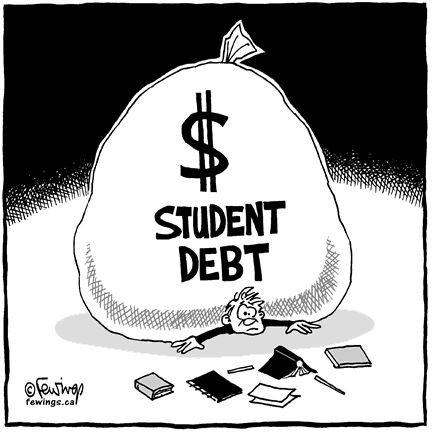
Lifestyle and career blog
Each year, millions of students walk out of the classroom, get a job and realize there's no earthly way they can make their student loan payments
and cover the rent.
A quick call to the student loan servicer results in a forbearance. But forbearance means your balance will keep going up while you get a breather. Once that ends, those student loan payments will be even worse.
Luckily, the federal government has ways of helping you minimize the pain of federal loans. Follow these quick steps to keep ahead of the game:
To understand what you're up against, get the facts about your student loans. Grab your Federal Student Aid PIN and head over to the National Student Loan Data System for Students to get a printout of all of your federal student loans.
The U.S. Department of Education has a Repayment Estimator to help you see monthly and overall payment estimates. You'll need to sign in with your Federal Student Aid PIN to use this tool.
If you've got multiple federal student loans, look into consolidation. This will make repayment easier because it brings all of your loans under a single servicer and allows you to make one payment. This
Forbes article breaks down the pros and cons of student loan consolidation.
Forbearance is a sucker's bet because it causes interest to capitalize. In other words, interest piles up during forbearance, and you end up paying interest on top of interest long-term.
Rather than falling into that trap, look into a repayment option that works for your financial situation. For many borrowers, repayment plans that hinge on your income will give you the best bang for your buck.
Federal Student Aid gives you a comprehensive overview of the repayment plans, but here's what you need to know:
Graduated repayment. The standard repayment option for federal student loans is 10 years, but most people make far less in the first few years after school than they do later on. The graduated repayment plan lets you keep payments low for the first two years, then rises gradually every two years for the life of the loan.
This is a tricky plan to take on because it results in far higher payments later on than would otherwise be the case. For those who need a little time to ramp up their income, however, it's a choice to consider.
Extended repayment. Rather than paying for 10 years, you can get your loan term extended to 20 or even 25 years. This will lower the monthly payment amount, but beware: by extending the term of the loan, you could be spending more than double on interest charges.
Extended graduated repayment. This is like the graduated repayment option, except it extends the repayment for up to 25 years.
As with graduated repayment, payments will skyrocket as time goes on. And the interest charges over the life of the loan will be much higher than in a 10-year repayment scheme. Use this option only when you've got no other viable choices.
Income-based repayment (IBR). Under IBR, your payments depend solely on your income and not on the amount of the loan. IBR is designed for people who are having financial hardship, and the payment due under this program will never be higher than what you'd pay under a 10-year standard repayment.
Payments change each year based on your income, and at the end of 25 years, the balance of the federal student loan debt is wiped away. You can check out a handy IBR calculator here.
Pay-as-you-earn (PAYE). PAYE, a program that was rolled out in 2012, is designed for newer borrowers. Like IBR, your payments and repayment terms are capped.
So, what are differences between PAYE and IBR? Under PAYE, you're paying 10 percent of your adjusted gross income when taking into account the poverty level, rather than IBR's 15 percent, and repayment under PAYE ends after 20 years rather than 25 years.
PAYE is a great option for newer borrowers. As time goes on, more will become eligible for this program.
Income-contingent repayment plan (ICR). ICR is similar to IBR, but payments are calculated differently. ICR depends in part on your income and loan balances and remains helpful if your loans don't qualify for IBR treatment.
If you've got federal student loans, you probably also have private educational debt. None of the above programs are available for private loans, so it's important to do everything you can to make those payments on time each month. Those private loans often carry higher interest rates, so it's a good idea to tackle those loans first.
Using one of the repayment options that lowers your monthly federal student loan debt can free up extra money for the private loans. Don't be shy; send in that extra money each month, and you'll work closer to your goal, little by little.
Jay S. Fleischman is a student loan lawyer practicing in New York City and the Los Angeles area. You can find him on Google+ and Twitter.
Brazen Life is a lifestyle and career blog for ambitious young professionals. Hosted by Brazen Careerist, we offer edgy and fun ideas for navigating the changing world of work. Be Brazen!Share your Comment: Get top stories and blogs posts emailed to you each day.

